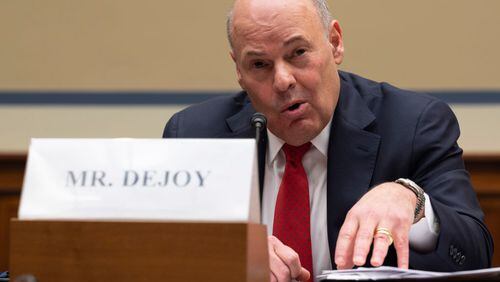About alternative investments:
Georgia pensions used to be restricted to traditional investments, such as stocks and bonds. But last year, the Legislature loosened the rules to allow for what’s known as alternative investments, such as buying stakes in private companies and employing complex trade strategies such as simultaneously buying and selling assets to profit from price differences.
The city of Atlanta’s three pension boards’ have agreed to invest $64 million in an alternative investment fund created by their adviser. That money is going toward what’s known as a “fund of funds,” a collection of elite, private investment pools. This approach spreads investments across several underlying funds to try to reduce risk.
Here are some basics about such investments:
How do the various funds work? Some "private equity" funds specialize in start-up ventures. Others target mature companies for takeovers or buy distressed and bankrupt firms. Others buy real estate. Hedge fund managers may borrow to supplement investors' capital and use complex trade strategies, such as betting that a stock will fall in price, known as short-selling.
Why invest in them? The potential for high profits. Such funds may do well through the ups and downs of financial markets. Last year, the best funds averaged returns topping 20 percent, Bloomberg reported.
What are their risks? Fees and expenses are high. With a "fund of funds," the investor pays the fees and expenses of both the fund of funds manager as well as the managers of the underlying funds. There are no rules on pricing such private funds, so the actual value of the fund may not be known until assets are sold. That may not happen for years, and there are often restrictions on when investors can cash out. Hundreds of private funds closed last year due to poor returns.
Who regulates them? They aren't subject to some of the investor-protection regulations that apply to mutual funds. New rules require large private funds to provide the Securities and Exchange Commission with information on exposures and risks. The public can't see that information; it is only available to the government to monitor risks to the financial system. Private funds with less than $150 million aren't required to file the new reports.
Sources: SEC, Bloomberg, staff research
Where Atlanta’s pensions invested
Atlanta’s three pensions had invested $20 million in their investment adviser’s “fund of funds” by the end of February, which was in turn invested in these six underlying private funds:
Fund,City,Type of fund,Amount
Millennium USA LP,New York,Hedge fund (arbitrage),$5.1 million
Third Point Partners,New York,Hedge fund,$6.3 million
Clearlake Capital,Santa Monica, Calif.,Private equity (buy-outs),$48,882
Edgewater Growth,Chicago,Private equity (start-ups),$2.2 million
Siris Partners II LP,New York,Private equity (buy-outs),$2.5 million
5 Stone Green Capital,Scotch Plains, N.J.,“Green” real estate,$3.0 million
Source: City of Atlanta, Bloomberg, staff research
Gray & Co.’s alternative fund
Atlanta-based Gray & Co., which has 37 employees, provides investment advice on $9.6 billion worth of assets to pension funds and other clients. It also directly manages about $742 million in investments for similar clients, according to regulatory filings. Here’s how it got into managing alternative investments, which promises to become one of its most lucrative businesses:
July 1, 2011: New pilot state law allows Georgia Firefighters Pension to become the state’s first public pension to invest in alternative funds.
Oct. 21, 2011: Gray & Co. launches its first private investment fund, GrayCo Alternative Partners I.
July 1, 2012: New state law allows most of Georgia’s large public pensions to invest in alternatives.
Sept. 11, 2012: Atlanta fire and police pensions agree to invest $15 million and $21 million, respectively, in Gray & Co.’s alternatives fund, to be called GrayCo Alternative Partners II. Gray & Co. is also the investment advisor for the city’s three pensions.
Oct. 4, 2012: Gray & Co. creates GrayCo Alternative Partners II.
Late October, 2012: Gray & Co. buys hedge fund manager Tiburon Capital Management, whose CEO becomes head of Gray & Co.’s alternative investment unit.
Nov. 7, 2012: Atlanta’s largest pension plan, its $1.1 billion General Employees plan, agrees to invest $28 million in GrayCo Alternative Partners II.
Dec. 5, 2012: Some board members at the General Employees pension question the adequacy of Gray & Co.’s disclosure of its financial interests in its alternatives fund. Move to reconsider decision is voted down. One member files complaint with the U.S. Securities and Exchange Commission.
April 1, 2013: Gray & Co. reports assets of $26 million in its first alternative fund and $77.9 million in its second fund.
July 18, 2013: Gray & Co. announces that founder Larry Gray is giving up CEO role but will remain president. To improve management and “support the continued growth of the firm,” Gray & Co. names co-CEOs and promotes Tiburon’s former CEO to be in charge of all investments.
Sources: SEC, Atlanta pension board meeting minutes and other documents, Delaware Division of Corporations, company statements, staff research
The financial adviser to Atlanta’s three pension systems recommended last year that they invest $64 million in a fund his own firm had just created, raising concerns about a conflict of interest.
The recommendation, approved by the city's firefighter, police and general employees pension boards, means $640,000 every year for the Atlanta firm, Gray & Co., to manage the fund. That's on top of the approximately $400,000 a year the pensions already pay the firm to help pick the best investments.
And if the fund performs well, Larry Gray’s company stands to make a fat slice of the profits — potentially millions of dollars more.
» DOCUMENTS: Disclosure agreement | Conflict of interest agreement
Critics say the arrangement is a conflict of interest because the city pension system’s financial adviser is profiting from his advice to the city. That conflict is compounded, experts say, because Gray & Co. also has an ownership stake in the fund. Some pension board members have complained they weren’t adequately told about the firm’s financial interests.
An Atlanta Journal-Constitution review of the arrangement also raises questions about whether it violated a state law enacted barely a year ago to allow public pensions to put money into so-called alternative investments, such as Gray's fund. These private funds buy long-term investments, such as distressed or start-up businesses. They are riskier but potentially more lucrative investments than stocks and bonds.
Gray and Atlanta officials say the transactions were legal. They also say it is common in the industry for investment firms to wear two hats, acting as both advisers and money managers.
“Absolutely … it is not a conflict,” Gray, 52, said during an interview Thursday at his Buckhead office.
Jim Beard, Atlanta’s chief financial officer and a member of all three pension boards, said Gray’s ownership stake does not impair its ability to impartially advise the pension plans. The $2.5 billion city pension system provides retirement benefits for almost 12,000 employees and retirees and their families.
“As a matter of fact, it’s a definite alignment of interests,” Beard said. “He has skin in the game.”
But Gray & Co. itself disclosed in an April filing with the federal Securities and Exchange Commission that the double roles created a "material" conflict of interest.
Ronald Hagan, chief executive of Roland/Criss, a Texas firm with expertise in pension trustees’ legal and financial duties, said Gray & Co.’s role amounted to a “staggering” conflict.
“The economic interest the adviser has compromises pretty severely its ability to provide uncompromising investment advice,” Hagan said. “At what point would individuals with economic interest at stake be comfortable recommending that the client dump the investment?”
James Meynard, executive director of the Georgia Firefighters Pension, questioned the wisdom of arrangements that allow for conflicting roles. That state pension fund, separate from Atlanta’s, was the first that Georgia lawmakers allowed to invest in alternative funds, starting two years ago.
Meynard said he specifically barred his board’s consultant from pitching its own alternative funds to the plan.
“How could you avoid the conflict of interest questions? There’s too much money involved,” he said. “I don’t want to pay you to make decisions you make money on.”
‘No one to watch the hen house’
Gray & Co. created the investment fund in October.
In November, Larry Gray brought the investment recommendation to Atlanta’s General Employee pension board, personally making the pitch, according to minutes from the meeting.
“Mr. Gray stated that time was of the essence in making a decision” because one of the underlying investments in the fund, which he referred to as Core Alts II, “was in fact closed to new investors,” the minutes say. “The commitment needed to be made now in order to get in, but capital calls for the actual money … would come later.”
There is no indication in the minutes that Gray disclosed his firm’s stake in the fund or that he referred to it by its actual name, GrayCo Alternative Partners II.
The board voted at that same meeting to approve his recommendation. The investment partnership agreement was signed that same day by Beard, Atlanta’s CFO, and Alfred Berry, Jr., the board’s chairman.
Shortly afterward, some board members said they didn’t understand Gray’s financial interest when they voted.
At the board’s next meeting, in December, Berry and two other board members asked for a vote to consider reversing the decision. They were voted down.
Gregory Nash, a General Employees board member who voted against the investment, said there would have been a much longer discussion had it been clear that Gray & Co. created the fund in which it was advising the city to invest.
“I don’t like the consultant being the manager — there’s no one to watch the hen house,” Nash said. “You can’t manage our money and your money at the same time.”
Angela Green, also a General Employees board member, filed a complaint with the SEC alleging that Gray & Co. violated federal disclosure regulations. The SEC declined to comment on the complaint.
“To me, I’ve just never known anybody to do that,” Green said of Gray’s dual role.
There is no reference in any of the minutes from the city’s other two pension boards’ public meetings in 2012 that show disclosure of Gray & Co.’s financial interest. Nor do the minutes reflect any substantive discussion of the merits of that fund or consideration of other funds.
Gray said the minutes of the General Employees meeting are inaccurate. He said he mentioned Gray & Co.’s financial interest “several times” in the meeting.
The AJC reviewed the portion of the official audiotape of the General Employees meeting where the alternative investment was discussed. During that time, Gray never mentioned the full name of his fund, GrayCo Alternative Partners II, or his firm’s financial stake in it. In fact, when a board member asked how much the investment would cost the pensions, Gray referred to his own company as “they.”
“They get 10 percent of any return over and above … a target of 8 percent,” he said. Earlier, asked about the expected return on the investment, Gray said it could top 20 percent.
In last week’s interview, Gray said that members of the three pension boards had opportunities to learn about the firm’s fund at other presentations.
“We work very hard to stay on the straight and narrow,” said Gray, whose firm has advised some of Atlanta’s pensions since 1996.
Given the long-term nature of alternative investments — Atlanta’s pensions are locked into the private fund partnerships for 10 years — Gray also said he took the process of picking investments very seriously. Asked why he didn’t recommend any other firms with more experience operating similar funds, he said he felt the investments “we were presenting were absolutely the best.”
Kelen Evans, chairman of the Atlanta firefighters pension board and a captain with the fire department, said he doesn’t consider the adviser profiting from city pension investment a conflict of interest. Some of his board members raised concerns, but those were soothed after they had an informal conversation, Evans said.
“We did have a meeting to make sure everybody was on the same page,” he said. “It wasn’t a public meeting — just a discussion among a few members. The way we see it, someone is going to get that fee. We’ve had a long-standing relationship with Larry Gray and we trust him. He has never steered us wrong.”
In the end, Beard, Atlanta’s CFO, said the fund Gray created was selected because the consultant was in the “unique position” of understanding the pension plans’ needs and the various players in the world of alternative investments.
State law requires consultants to provide investors they advise with written notification of any conflict of interest. In response to an AJC request for any such disclosure, the city provided Gray & Co.’s contract for the new fund.
The 52-page document details the compensation arrangement, gives Gray the authority to purchase property and other services from its affiliates, and acknowledges the deal "may give rise to conflicts of interest" between Gray and the city pensions.
It is unclear if all board members saw the contract before voting.
Law ‘vague’
Until last summer, Georgia had allowed only Georgia Firefighters Pension, in a pilot program, to use alternative investments. Many were wary that such investments were too costly, risky and secretive, and opened the door to unwise or politically-connected investments. Should the investments fail, shortfalls could come out of taxpayers’ pockets or erode the pensions of tens of thousands of public employees.
To guard against some of the risks, the law put limits on how much public pensions can invest. Lawmakers also specified that money could only go to funds that have at least four investors that are not related to the manager; required that funds have a total investment of at least $100 million; and barred public pensions from holding more than 20 percent of the total investment.
Those requirements are “one of the biggest protections,” said Kelly Moody, assistant director for the state’s second-largest public pension plan, the $14.3 billion Employee Retirement System, which helped shape the law.
“This makes it virtually impossible for an investment to be made due to political pressure,” she said, “as it would be impossible to find four or more investors for an investment that they would not otherwise make on the merits of the investment itself.”
ERS, the Georgia Firefighters Pension and others all have the same understanding of the requirements.
By their interpretation, at the time the city pensions joined Gray & Co.'s fund it would have needed at least $100 million and at least five to eight investors — depending on whether the Atlanta pensions are counted as one or three investors — and the pensions' stakes couldn't exceed 20 percent of the total.
Gray told general employees board members in November that five other pensions already had signed up for the fund, including a local hospital, two states and a city in Illinois.
“They’ve already approved, already signed the document. It’s already executed,” Gray said to the board, according to the audio recording.
That’s not what documents that Gray & Co. filed with the SEC in April show.
On the documents, the fund is listed as having $77.9 million in assets, including Atlanta’s commitment — not $100 million. Asked in the documents for the approximate number of investors, the firm reported four including itself, which some experts say is under the requirement. At the time, Atlanta’s three pension plans accounted for a third of the investments, according to financial reports provided by the city. Some experts say that is too high.
Last week, Gray & Co. officials said the fund had enough investors to meet the law’s requirements, but offered differing counts.
Initially, officials said when the city plans signed up, the fund had two other investors, a total of five.
But they had also earlier said the company’s April SEC filing reporting four investors accurately reflected the size of the fund at the end of 2012 — after the Atlanta plans had joined.
Friday, Gray said he had contracts with the five investors mentioned in the General Employees meeting — besides the three city plans that were joining — but they weren’t included in the SEC filings because some details were still being negotiated.
Company officials also said language in the state law is vague, but they believe they met the law’s requirements.
“Our interpretation is that you can’t count that number (to meet the state law’s requirements) until the fund is closed” to new investors, he said. He expects the fund to have $150 million and several more investors by the time it stops accepting new investors.
He said he also believes the state law’s requirements are met by Gray & Co.’s overall size — $850 million under management, with dozens of clients, and more $100 million in two different alternative investment funds, with a third planned.
The city’s law department also maintains the investment is legal.
Yvonne Yancy, the city's human resources commissioner who sits on all three boards, said the bottom line is that the boards' deal with Gray is a smart investment.
“Our objective is to grow our assets,” Yancy said. “If our financial adviser … or any other entity offers a vehicle that does that for us, I think we should consider it. The question comes down to the performance of the product and the performance of the manager. That’s our focus. Period.”
About the Author





